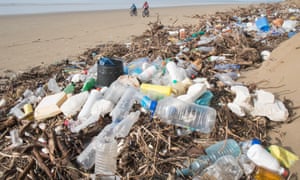Extract from The Guardian
UK National Oceanography Centre, which studied waters between Britain and Falklands, says action needed urgently
More than 10 times as much plastic has been found in the Atlantic ocean than previously estimated to be there, showing the the world’s plastic problem is likely to be much greater than realised.
New measurements of the top 200m of the Atlantic found between 12 and 21 million tonnes of microscopic particles of three of the most common types of plastic, in about 5% of the ocean. That would indicate a concentration in the Atlantic of about 200 million tonnes of these common plastics.
Previous estimates, based on calculations of the amount of mismanaged municipal waste in coastal areas, were that between 17 million and 47 million tonnes of plastic had been released into the Atlantic in total over the 65 years from 1950 to 2015.
Katsiaryna Pabortsava, of the UK’s National Oceanography Centre, and lead author of the study, said: “Our key finding is that there is an awful lot of very, very small microplastic particles in the upper Atlantic ocean, much higher than the previous estimate. The amount of plastic has been massively underestimated.”
She said the discovery should spur policymakers to consider what could be done to stop so much plastic reaching the seas, where it endangered marine life. She added that people still knew too little about the dangers.
“Society is very concerned about plastic, for ocean health and human health,” Pabortsava said. “We need to answer fundamental questions about the effects of this plastic, and if it harms ocean health. The effects might be serious, but might take a while to kick in at sub-lethal levels.”
In order for policymakers to stop plastic reaching the oceans – where it stays for decades, breaking up into smaller and smaller particles – they need better understanding of the sources, and how it behaves once in the water. “The sources of plastic in the ocean have not been quantified properly,” said Pabortsava. “We really don’t know enough about how much plastic is going into the ocean, and where from.”
The findings, published in the journal Nature Communications, followed other research that showed the scourge of plastic in the oceans was likely to be greater and growing faster than had been recognised.
Research published in April showed that microplastics were found in greater quantities than ever before on the seabed, in areas suggesting they had been carried to the bottom by strong currents and concentrated in hotspots. A further study in May concluded that the amount of microplastic in the ocean had been underestimated, and that the particles could outnumber zooplankton.
Last month, a major study by the Pew Trusts and others found that the amount of plastic entering the oceans was likely to triple in the next 20 years, on current trends.
Jim Palardy, director of conservation science at the Pew Trusts, who was not involved in this week’s Nature paper, said: “[This] study not only shows that we have a lot to learn about the scale of ocean plastic pollution, but also highlights the need for immediate and sustained action to tackle this urgent issue. Although it may be daunting, ocean plastic pollution is not an insurmountable problem.”
Action was urgently needed, he said: “Our recent study found that existing technologies can greatly reduce the amount of ocean plastic – if we make immediate changes.”
Scientists are poised to learn more about the potential harms to health from microplastic pollution. Earlier this week, researchers reported on a new technique that would allow them to detect the presence of microplastics in human organs.
For the latest paper, scientists from the UK’s National Oceanography Centre collected seawater samples at 12 locations along a route across the Atlantic, from Britain to the Falklands, between September and November 2016. They took large volumes of seawater from three depths in the top 200 metres of the ocean, then filtered it and used spectroscopic imaging to detect microparticles of polyethylene, polypropylene and polystyrene, three of the most commonly used plastics, reckoned to make up more than half of global plastic waste.
They found up to 7,000 microparticles of these three plastic types per cubic metre of seawater in the samples.
While the findings apply only to the Atlantic, and cannot be extrapolated to the Pacific or other areas, they indicate that our knowledge of the true extent of the plastic problem is incomplete. “Other oceans are also severely under-sampled,” Pabortsava said.

No comments:
Post a Comment